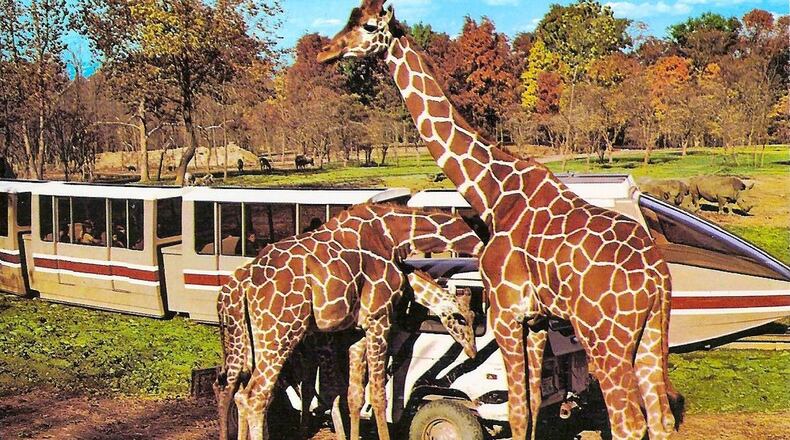While the attraction created happy memories for its millions of riders, the Lion Country Safari is almost as infamous for its numerous incidents and controversies.
Credit: Contributed
Credit: Contributed
Kings Island announced its plans to open a wildlife preserve in September 1972, partway through its first operating season. While short on specifics, the park did announce its partner for the ride, Lion Country Safari Inc., which operated several similar attractions across the country. In fact, a Lion Country Safari still operates today in Palm Beach County, Fla.
The projected cost for the ride was listed as $2 million, or roughly $15 million when adjusted for inflation.
Construction on the project began the next year, and by the end of Kings Island’s 1973 season, the park was in possession of two lions, nine rhinos, and 16 zebras.
Unlike the other installations of the Lion Country Safari, where guests would drive through the route in their cars, guests at the Kings Island iteration would experience the safari in a monorail, similar to those seen at various Disney resorts.
Credit: Contributed
Credit: Contributed
Before opening, Kings Island also decided the attraction would charge separate admission and be open throughout the year, despite the cold winters common in Ohio.
Animal plans
“We don’t give animals enough credit for adapting,” said project lead Warren Taylor when asked about the weather. “The lion will lie down with the lamb, really, if both of them need to keep warm.”
To help accommodate the animals’ needs, the park would provide them with heated barns. Kings Island officials also took precautions to make sure Ohio’s native plant life, such as the poisonous buckeye, wouldn’t harm the animals.
Throughout the remainder of 1973 and early 1974, the last of the animals arrived and construction was completed. The final cost of the project was approximately $7 million, over three times the original estimate.
Kings Island opened for the 1974 season alongside the Lion Country Safari on April 27.
Large area of the park
Housed in a new area of the park, where the Action Zone now stands, guests would enter the attraction through a recreation of an African village.
Credit: Contributed
Credit: Contributed
With a track length of more than two miles, the 20-minute trek was split into three sections — one for the larger animals, one for the lions and one for the smaller creatures. On opening day, the safari featured 60 lions, 25 zebras, 12 elephants, six giraffes, 25 rhinos, 6 hippos, 30 ostriches and 125 antelope.
The week of the attraction’s opening, the Cincinnati Enquirer published an article interviewing a woman who claimed the park refused to hire her as a ranger due to her gender. The Oregon State University student, who spent time in Kenya and other east African nations working with animals, claimed she was told by the park’s director of marketing she was denied because “once a month women are more likely to be attacked by lions.”
This argument is based on the urban legend which claims certain animals such as bears and sharks are attracted to menstrual blood. No evidence exists to back up this theory.
The park denied these accusations, saying the woman simply “wasn’t as qualified as others.”
Escape artists
It wouldn’t take long for the first animal-related accident to occur at the park, as in June of 1974, a power outage allowed a lioness to escape her enclosure and wander the safari grounds. Fortunately, additional fencing made sure the lion couldn’t reach guests, trapping the animal in a “no man’s land.” After three days, park staff were successfully able to tranquilize and apprehend the lion.
While the rest of the Lion Country Safari’s inaugural year proceeded without incident, a lack of attendance caused the preserve to close weekdays during the winter season.
Credit: Contributed
Credit: Contributed
A major incident wouldn’t occur again until October 1975, where one of the safari’s trainers went to a Mason bank with Bwana, a lion cub, after visiting a nearby school. While the two were waiting in the lobby, a 13-month-old child broke free of her mother and ran toward Bwana, and the cub responded by grabbing the girl with his mouth.
The trainer then pulled on Bwana’s leash, which made him release the child, who was unharmed.
While Bwana was declawed, “there’s no doubt the lion could crush the girl’s skull,” said his handler after the situation. “I think this proves the animal is well trained.”
For the 1976 season, Kings Island added 10 Bengal tigers and 50 baboons to the safari, but the primates would prove to be quite troublesome. Soon after their arrival, all 50 of the normally timid baboons were able to climb the 12-foot-tall fence and roam throughout the park.
The next several weeks would see park staff try to contain the animals in a variety of ways. Officials were able to use fruit to lure a number of the primates back to their enclosure, which they promptly escaped from once again.
While most of the baboons stayed together in a large pack, outrunning any humans who tried to approach, one was able to escape Kings Island property, and park officials were forced to shoot the animal before it could harm anyone.
Safari workers were able to successfully round up the monkeys by using electrified fences and drugged food. All of the baboons were shipped back to the International Animal Exchange aside from two, who were displayed in a cage alongside a sign which said “Here are a few of the baboons that made monkeys out of us.”
Another situation occurred just a few months later, where a 20-year-old park ranger was mauled to death by a lion after leaving his patrol vehicle. An investigation was then conducted by the Occupational Safety and Health Administration, finding several violations within the park. Kings Island faced a $2,400 fine for these infractions, later brought down to just $800.
These incidents eventually led Kings Island to operate the attraction internally, terminating its contract with Lion Country Safari in 1977.
The preserve, now known as the Wild Animal Safari, also added creatures from North America to its lineup in 1977, with the safari now split into different sections by continent.
After the change in ownership, major emergencies became less frequent at Kings Island’s safari, but didn’t stop entirely. In 1979, a small fire broke out, killing five African antelopes and destroying a heated shelter. Another ranger was nearly killed by a lion in 1982, but was saved by a coworker who struck the animal with the end of her gun.
Lions were then removed entirely from the preserve just a year later, a move the park claimed was unrelated to the attack.
Credit: Contributed
Credit: Contributed
During this time, the park collaborated with the nearby Cincinnati Zoo to take part in the new field of cross-species implanting, where a mother from one species would be given a fertilized embryo from another. This began in 1981, where one of the park’s lions was implanted with two embryos from a Bengal tiger, who had lived at the park for five years but had yet to reproduce. Unfortunately, the experiment was unsuccessful and the lioness was not able to complete her pregnancy.
Later in the decade, the park was successful in implanting a Holstein cow with the embryo of a gaur, a cattle species native to India. The baby, named Ralph, celebrated his first birthday in 1988.
Credit: Contributed
Credit: Contributed
At the start of the 1990s, Kings Island itself would face a major shakeup, as entertainment company Paramount purchased the park in 1992.
The Wild Animal Safari, with a name that was changed once more to the Wild Animal Habitat, lasted just one season under the new management.
Saying goodbye
On Nov. 3, 1993, Paramount Parks announced the safari would close after 19 years of operation, and the land would be used for future development “of attractions that bring Paramount movie, television and publishing intellectual properties to life.”
The park went through the process of finding new homes for all the animals, a task with which the Cincinnati Zoo assisted.
The large plot of land the safari once stood on has been the home to a variety of attractions, including Son of Beast, Flight of Fear, Firehawk and Orion.
After dismantling the monorail, the ride vehicles were placed into storage for several years, before being purchased in 1998 by international grocery store Jungle Jim’s for just $1.
Jungle Jim’s would spend the next several years refurbishing the cars to run on bio-diesel fuel, as well as building a new track. The monorail finally opened at its new location in 2011.
While not operational during regular hours, Jungle Jim’s guests can still ride the over 50-year-old attraction during special events.
Jungle Jim’s Eastgate location, which opened in 2012, also features a monorail, though it is nonfunctional.
Alex Cutler is a Lifestyles reporter who covers Kings Island and other entertainment venues and events in Southwest Ohio. Email him at alex.cutler@coxinc.com.
About the Author












